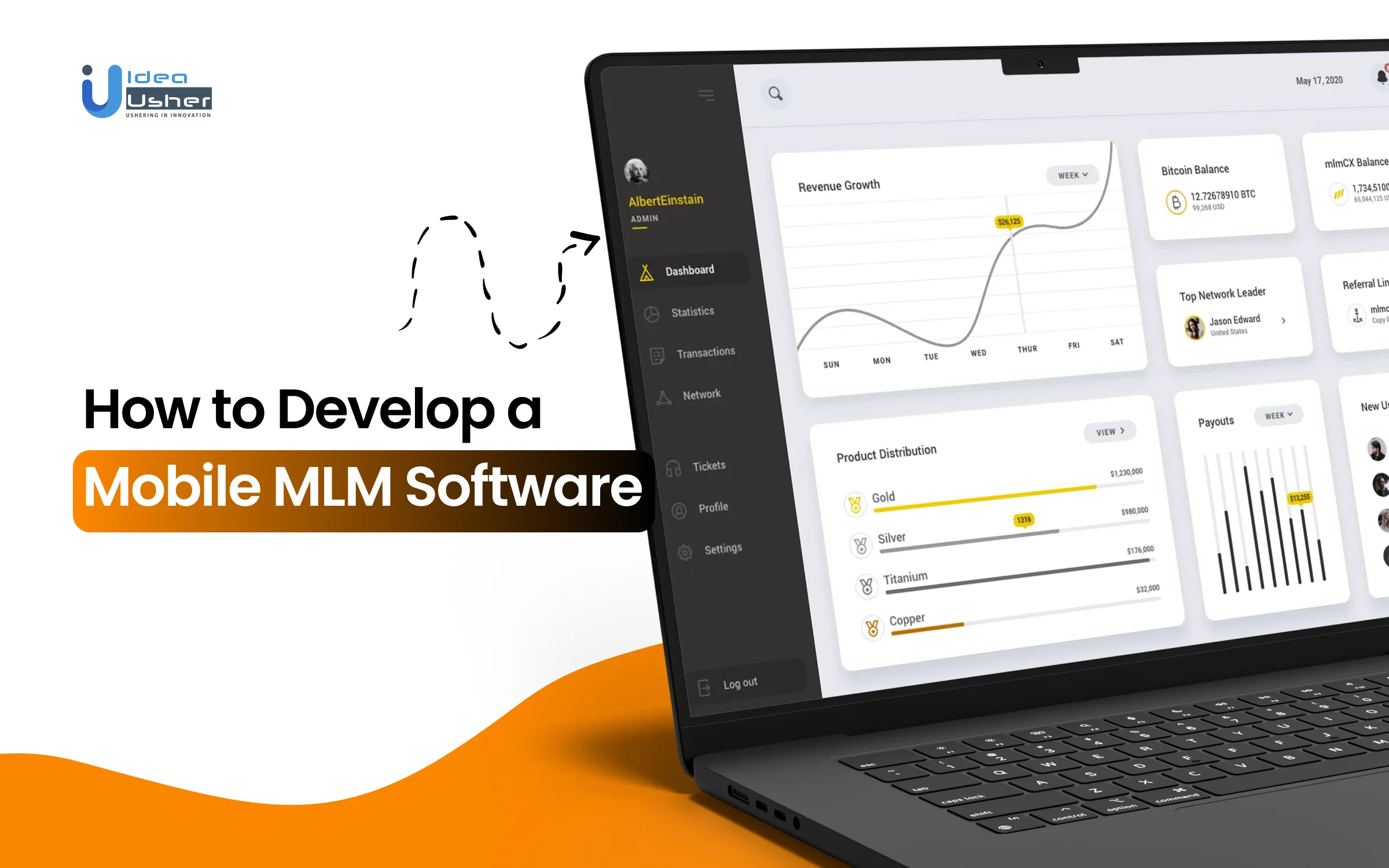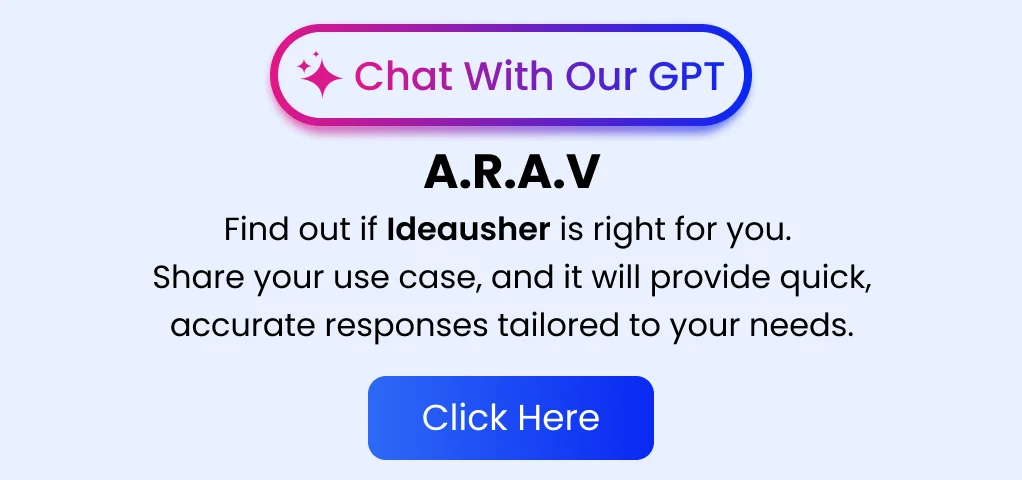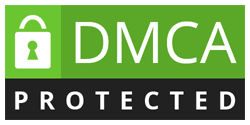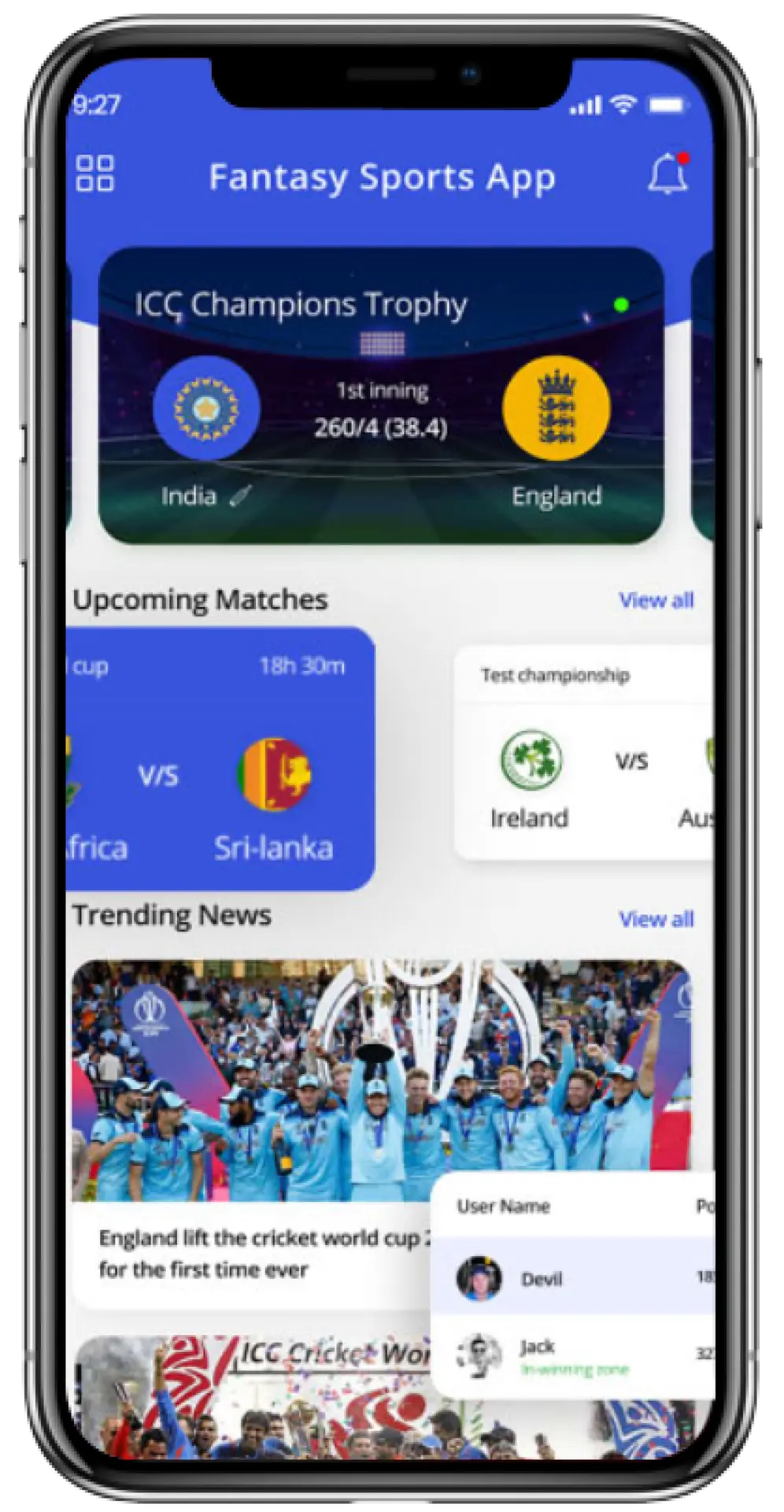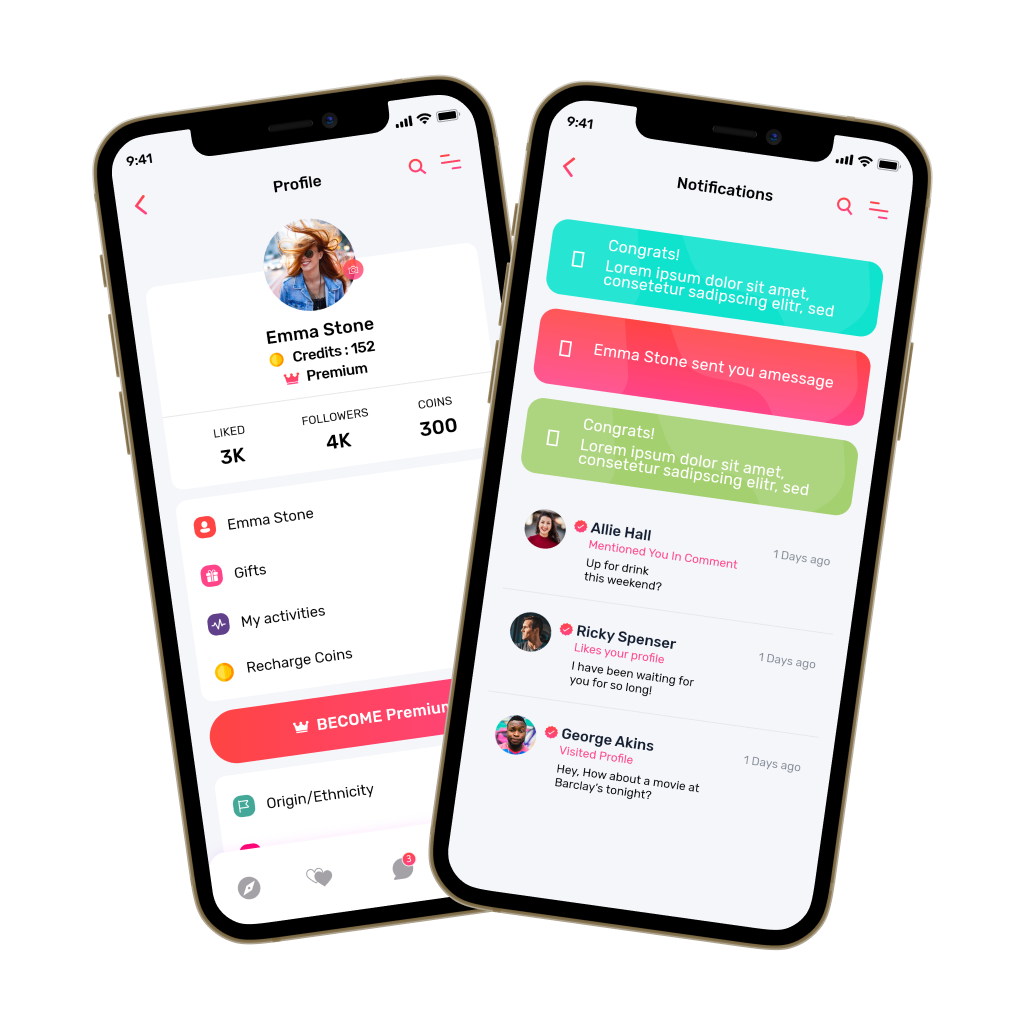Managing multi-level marketing operations can be complex, especially when teams are spread across regions and rely on manual tracking. Without an efficient system, tracking sales, commissions, and downline performance can become chaotic. A mobile MLM software simplifies these challenges, providing real-time insights, automated calculations, and easy communication for distributors and managers alike.
Modern mobile MLM software goes beyond basic management. Features like automated commission tracking, secure payment integration, real-time analytics dashboards, and push notifications empower users to stay connected and informed. Leveraging cloud infrastructure, responsive mobile design, and secure databases ensures smooth performance and data integrity across devices.
In this blog, we’ll walk you through the process of developing a mobile MLM software, from essential features and tech stack considerations to compliance and scalability tips. Whether you’re creating a platform for a growing MLM network or modernizing an existing one, this guide provides actionable insights to build an efficient and reliable solution.

What is Mobile MLM Software?
Mobile MLM software is a dedicated application designed to help network marketing companies manage their distributors, track sales, calculate commissions, and monitor team structures directly from mobile devices. It streamlines everyday operations by making essential tools accessible from anywhere, ensuring distributors can work, track progress, and communicate on the go.
Beyond basic management, modern mobile MLM software boosts scalability and engagement through features like automation, real-time data, and seamless collaboration. This enables capabilities such as:
- Streamlining distributor and team management by organizing profiles, tracking downlines, and maintaining clear genealogy structures.
- Automating commission and payout processes to ensure accuracy, reduce manual workload, and maintain full transparency across the network.
- Centralizing business operations so distributors can access tools, resources, and updates in one unified mobile platform.
- Supporting consistent communication between uplines, downlines, and company administrators for faster decision-making.
- Enhancing sales tracking and performance monitoring through real-time data visibility and progress insights.
- Improving distributor onboarding and retention by offering easy access to training materials, company updates, and product information.
- Enabling on-the-go business activities so distributors can work, engage, and grow their network anytime, anywhere.
How Mobile MLM Software Works?
Mobile MLM software lets distributors and admins manage teams, track sales, and calculate commissions from a mobile device, simplifying growth and daily operations.
1. User Onboarding & Network Placement
The process begins when a distributor registers through the app, and the system automatically positions them in the correct genealogy structure to set up their starting point. This ensures accurate placement and prevents errors in network tracking.
2. Sales Activity & Team Growth Tracking
As users place orders and build their teams, the software updates sales data and rank progress in real time, giving everyone instant visibility into their performance. It also highlights high-performing distributors to guide team strategy.
3. Automated Commission Processing
The system applies the chosen compensation plan to calculate commissions and bonuses automatically, updating all earnings directly in the distributor’s e-wallet. It reduces manual errors and ensures transparent, timely payments.
4. Financial Transactions & E-Wallet Management
Distributors can then review their balance, transfer funds, or request withdrawals through secure, integrated payment gateways within the app. The system also records all transactions for easy tracking and auditing.
5. Admin Oversight & Reporting Completion
The workflow ends with admins reviewing analytics, sales reports, and payout summaries to validate performance and guide future decisions. It also enables monitoring of growth trends and team efficiency.
Top MLM Compensation Models You Can Consider
As more companies adopt mobile MLM software development to streamline team management, choosing the right compensation model becomes even more important. A clear understanding of each plan helps you build a structure that supports growth and distributor success.

1. Binary Plan
In a binary plan, distributors build two primary legs, left and right, with earnings based on the weaker leg’s volume. This structure promotes quick duplication and offers a simple model that’s easy for teams to understand.
Pros
- The system is easy for new distributors to understand, which makes duplication and team-building much faster.
- It naturally encourages balanced growth because earnings depend on maintaining both legs.
Cons
- Many distributors struggle to keep both legs balanced, which can slow down earnings.
- Income is always limited by the performance of the weaker leg, even if the stronger side grows rapidly.
2. Unilevel Plan
This model lets every distributor enroll as many frontline members as they want, with commissions typically paid down a set number of levels. It’s ideal for brands that value transparency and want a straightforward plan that feels fair and honest to newcomers.
Pros
- The structure is extremely straightforward, making it simple to explain and easy for newcomers to follow.
- Because it lacks complicated placement rules, it reduces the chance of manipulation within the system.
Cons
- Team-driven earnings can grow slowly, especially if distributors don’t build wide frontlines.
- Commissions stop after a certain depth, which means very deep teams may not generate additional income.
3. Matrix Plan (Forced Matrix)
A matrix plan limits how many people each distributor can have on their frontline (e.g., a 3×7 structure). Extra recruits beyond the cap “spill over” into the downline. Companies use this for controlled growth and to encourage teamwork, especially in online or funnel-driven settings.
Pros
- The spillover effect can motivate team members, as they may benefit from efforts made by their uplines.
- This structure encourages strong teamwork since everyone’s placement affects the group’s success.
Cons
- The fixed width limits how many people a distributor can personally enroll on their frontline.
- Success often depends heavily on the strength and activity of the upline, which can be discouraging for self-driven individuals.
4. Stair-Step Breakaway Plan
Distributors advance through sales ranks, and upon reaching a performance threshold, they form their own leadership team. This model suits businesses focused on leadership development and building stable, long-term teams.
Pros
- It rewards distributors who develop leadership skills and invest in building strong teams.
- Over time, it creates a stable organizational structure that can generate long-term residual income.
Cons
- The system can be complicated for new members to grasp, especially the breakaway rules.
- When team members break away, it can feel confusing or even discouraging to those who don’t yet understand the benefits.
5. Hybrid/Combination Plan
A hybrid plan combines two or more MLM models, such as binary and unilevel, to create a flexible compensation structure. Companies adopt it for diverse products and a more balanced earning approach.
Pros
- Companies can design the structure to match their exact business goals, creating a compensation plan that feels more balanced.
- A blend of models often results in better earning opportunities across different types of distributors.
Cons
- The final plan can feel complex without proper training because multiple systems are combined.
- New distributors may need more time to fully understand how the compensation works.

Why Do 60% of U.S. Distributors Now Rely on MLM Software?
The MLM Software Market was valued at USD 600 million in 2024 and is projected to reach USD 1,259.12 million by 2031, growing at a CAGR of 9.97%. This growth is driven by increased digital transformation and the adoption of automation, mobile apps, and AI systems in direct-selling companies.

60% of U.S. distributors now use MLM software to manage commissions, track downlines, communicate with teams, and streamline operations, reflecting a demand for smarter tools that give companies a competitive edge.
Why the MLM Software Market Welcomes New Platforms?
Even with existing players in the market, there is plenty of room for new MLM platforms to succeed, especially those focused on mobile-first experiences, better UX, regional customizations, and AI-driven features.
Here’s why:
- The MLM industry is not only growing but also changing, as millions of distributors join each year in areas like wellness, beauty, personal care, and digital products.
- Emerging markets like Latin America, Eastern Europe, Africa, and South Asia are seeing rapid adoption, creating opportunities for region-specific platforms.
- Mobile-first management is now essential, with distributors expecting real-time dashboards, genealogy views, order tracking, and instant commission insights on the go.
- Automation streamlines operations by handling payouts, onboarding, compliance, and team updates, reducing friction for both companies and distributors.
- Digital tools such as structured onboarding, training portals, and automated workflows boost retention and enable teams to scale efficiently.
Overall, new MLM platforms can still capture large market segments by offering better usability, personalization, or advanced features missing in legacy systems.
Why Do AI-Driven MLM Platforms Boost Engagement & Retention by 75%?
As strong as today’s MLM software market is, an even greater opportunity lies in the next wave: AI-powered MLM platforms. Companies using AI-driven tools report up to 75% improvements in engagement and retention, making AI the biggest advantage for new entrants.
- AI-powered lead scoring: Identifies high-conversion prospects by analyzing user behavior, interests, communication patterns, and social signals.
- Personalized automated onboarding: AI adapts training paths to distributor skill levels, learning speed, and past performance, boosting early success rates.
- Predictive analytics for team growth: AI identifies who is likely to become a top performer, who needs support, and where team expansion will be most effective.
- Automated content creation: AI generates targeted scripts, product posts, follow-up messages, and promotional stories for distributors.
- Smart commission & team optimization: AI reduces payout errors, suggests ideal team placements, and helps create a more balanced, productive downline.
The MLM software market is rising steadily, distributor adoption is higher than ever, and digital transformation continues to accelerate global network growth.
The real breakthrough comes from AI-powered MLM platforms. These solutions bring clear improvements in engagement, retention, productivity, and team performance.
For anyone planning to launch an MLM or AI-MLM platform today, the timing couldn’t be better:
- The current market is strong
- Demand for smarter tools is increasing
- AI-driven features create instant differentiation
- Emerging markets offer massive room for expansion
Launching your MLM or AI-powered MLM platform now puts you in the next major growth wave of the industry.
Key Features to Integrate in a Mobile MLM Software
Effective mobile MLM software development streamlines team management, sales tracking, and commission automation, making the network easier to grow and manage. Here are the key features every successful MLM app should have.

1. Seamless Distributor Onboarding
A smooth onboarding system lets new users join easily. The software should automate sponsor assignment, verify identity, and place distributors correctly in the hierarchy. This ensures an accurate network structure from day one and avoids referral mistakes.
2. Genealogy Tree & Network Visualization
MLM structures can be complex, so a visual genealogy tree is essential. It lets distributors see their downline, track active members, analyze team depth, and understand network growth. A good tree aids planning and keeps users engaged with team progress.
3. Advanced Commission & Bonus Management
A key feature of MLM software is automated commission calculation. The system should support various payout rules like weekly, monthly, or rank-based and update earnings in real time. This reduces errors, boosts transparency, and ensures distributors always see how their activities generate income.
4. Digital Wallet & Transaction Tracking
A built-in wallet helps distributors manage earnings, bonuses, withdrawals, and internal purchases. Real-time transaction history builds trust, while withdrawal requests, payout summaries, and automated ledger updates minimize the administrative load on the company.
5. Product Catalog & Order Management
For product-driven MLMs, an intuitive catalog and order system is essential. Users should browse items, place orders, track shipments, and view purchase history, all within the app. This streamlines the sales cycle and boosts product movement across the network.
6. Performance Dashboard & Analytics
Personal and team performance analytics give distributors actionable insights. A dashboard highlighting ranks, active legs, sales volume, bonuses, and growth metrics helps users make informed decisions. Admins also benefit from network-wide analytics to monitor performance trends and address bottlenecks.
7. Lead & Sales Tracking System
A robust lead and sales tracking system helps distributors monitor prospects, follow up efficiently, and record sales in real time. It ensures accurate pipeline management, improves conversion rates, and provides visibility into team performance across the network.
8. Push Notifications & Real-Time Alerts
Real-time updates are crucial in MLM operations. Notifications about commission updates, rank changes, team activity, order updates, or promotional campaigns keep distributors engaged and informed. This drives activity and helps teams respond quickly to opportunities.
9. Fraud Prevention Tools
MLM platforms process sensitive financial and network data, making strong security essential. Fraud detection tools spot suspicious activity like duplicate accounts, fake sign-ups, or unusual commission claims. Secure access controls and encryption protect the business and users.
10. Admin Control Panel
A robust admin panel gives the company full visibility and control. Administrators can configure compensation, review transactions, approve payouts, manage products, track network health, and generate reports. This supports operational stability and regulatory compliance.
Advanced Features That Can Give You a Competitive Edge
To stay ahead in mobile MLM software development, your platform needs smart, modern features that improve accuracy, engagement, and overall distributor performance.
- AI-Powered Lead Scoring & Insights: AI analyzes behavior and engagement patterns to highlight high-quality leads and suggest the best times and methods for follow-ups.
- Automated Commission & Payout System: The platform handles complex MLM structures and calculates commissions instantly, ensuring accurate, transparent, and timely payouts.
- Real-Time Sales and Team Analytics: Live dashboards let distributors track sales, rank progress, and team activity, helping them identify opportunities and gaps quickly.
- Built-In E-Wallet With Fast Withdrawals: Users can store commissions securely and access instant withdrawal options through integrated payment gateways.
- Automated Recruitment Funnels: Customizable landing pages and automated follow-up sequences help distributors manage prospects more efficiently.
- Targeted Push Notifications: Personalized updates, reminders, and promotions keep distributors engaged and informed in real time.
- Multi-Language & Multi-Currency Support: The platform adapts seamlessly to global markets, making international expansion easier for growing MLM companies.
- API and Third-Party Integrations: Smooth integration with CRM systems, ecommerce tools, and payment gateways enhances overall efficiency and flexibility.

How to Develop a Mobile MLM Software?
Mobile MLM software development needs a clear strategy, the right tech stack, and strong knowledge of network marketing. Mobile MLM software enables seamless, on-the-go experiences for distributors to manage teams, track sales, and accelerate growth.
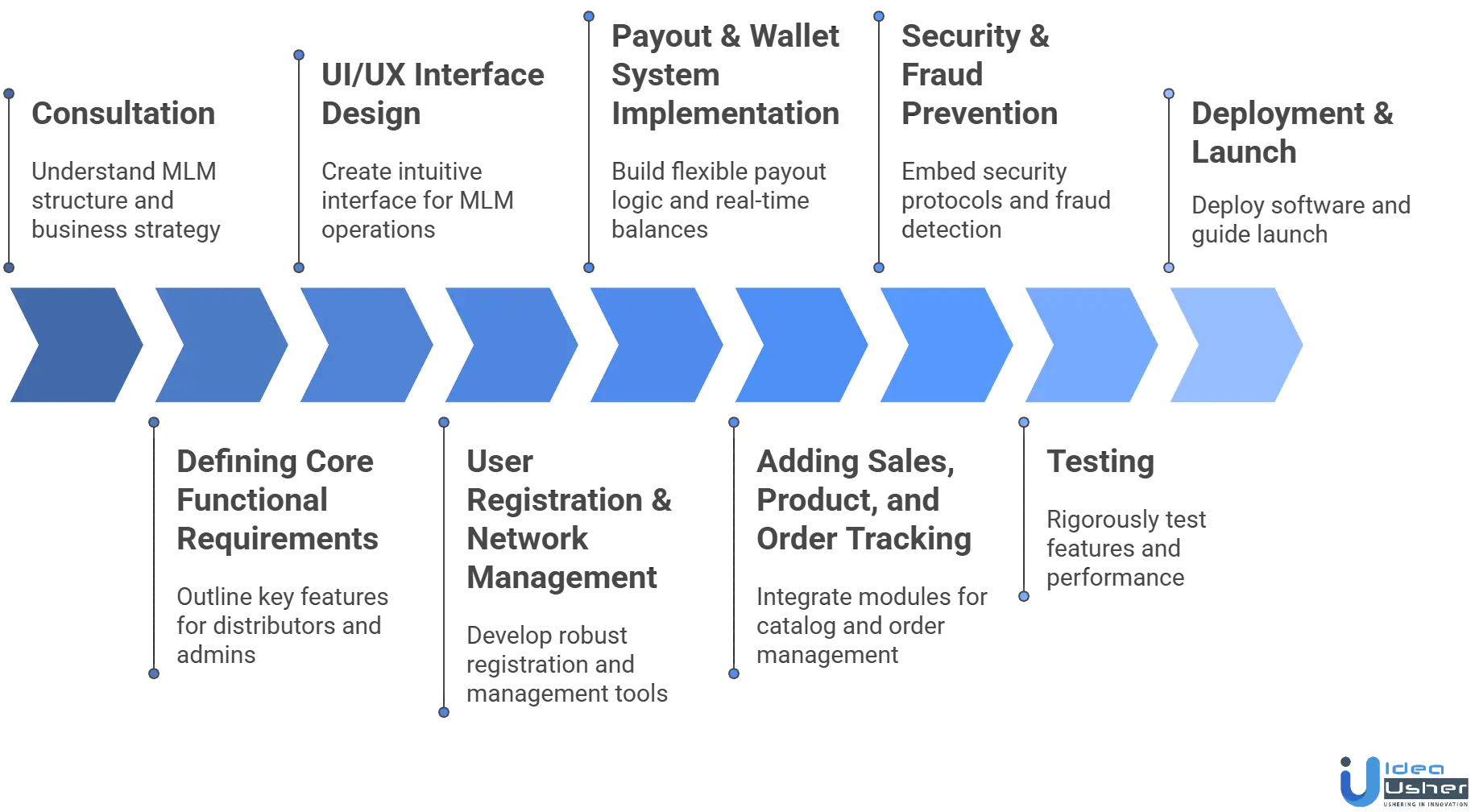
1. Consultation
Our first step is to thoroughly understand your MLM structure like binary, matrix, unilevel, or hybrid. We analyze compensation plans, commission rules, hierarchies, and growth expectations to ensure the software fits your business strategy. This early validation helps prevent structural issues later in development.
2. Defining Core Functional Requirements
Once the MLM logic is clear, we outline the key features your mobile software needs like onboarding, genealogy, commission tracking, wallet management, and analytics. Our developers turn your requirements into functional modules for smooth workflows for distributors and admins.
3. UI/UX Interface Design
We design an intuitive interface to simplify complex MLM operations, featuring clean dashboards, easy navigation, and visual hierarchy trees for quick network understanding. Our team ensures a user-friendly experience that aligns with your brand identity.
4. User Registration & Network Management
At this stage, we develop a robust registration system that allows new distributors to join seamlessly, assign sponsors correctly, and automatically map their position within the MLM structure. We also create tools for leaders to manage downlines, track growth, and oversee team performance with clarity.
5. Payout & Wallet System Implementation
A core function of MLM software is calculating commissions accurately and on time. We build flexible payout logic that adapts to your compensation plan, supports bonuses, and maintains real-time wallet balances. This ensures transparency and minimizes manual intervention for your finance team.
6. Adding Sales, Product, and Order Tracking
If products or services are involved, we integrate modules for catalog management, order processing, and sales tracking. This allows distributors to monitor their personal and team performance, helping them stay focused on targets while giving admins full operational visibility.
7. Security & Fraud Prevention
MLM platforms must handle sensitive financial and network data, so we embed strong security protocols to protect user information and transaction history. Our team also incorporates compliance checks and fraud detection mechanisms to prevent manipulation of referrals, commissions, or recruitment chains.
8. Testing
Before launch, we rigorously test every feature including user flows, commission calculations, network mapping, and security layers. Our goal is to identify issues early, eliminate bugs, and ensure the app performs consistently across different devices and user loads.
9. Deployment & Launch
Once testing is complete, we deploy the mobile MLM software to the required platforms and guide you through a smooth launch. After release, we monitor performance, gather user feedback, and optimize features to support scalability as your distributor network grows.
Cost Breakdown for Developing a Mobile MLM Software
Before breaking down the costs, it’s important to note that MLM platforms require reliable logic, secure financial handling, and scalable network management. Each development phase contributes significantly to the platform’s long-term stability and user trust.
| Development Phase | Description | Estimated Cost |
| Consultation | Understanding your MLM model, compensation plan, operational workflows, and compliance rules. | $4,000 – $8,000 |
| Feature Planning | Defining modules, user roles, payout logic, and creating a scalable architecture for the MLM structure. | $6,000 – $10,000 |
| UI/UX Design | Designing user-friendly dashboards, genealogy trees, admin panels, and mobile flow for distributors. | $8,000 – $13,000 |
| Core MLM Engine Development | Building the logic for network mapping, hierarchies, sponsor assignment, rank calculations, and team management. | $18,000 – $30,000 |
| Commission, Wallet & Payout System | Implementing automated commission calculations, wallet features, bonus rules, and payout integrations. | $15,000 – $22,000 |
| Sales, Product & Order Management | Adding product catalogs, order tracking, invoicing, and sales performance dashboards. | $10,000 – $18,000 |
| Security & Fraud Prevention | Adding data protection layers, transaction security, compliance checks, and anti-fraud safeguards. | $6,000 – $12,000 |
| Testing | Functional, performance, and security testing to ensure the MLM software runs smoothly. | $5,000 – $10,000 |
| Deployment & Post-Launch Optimization | App deployment, bug fixes, monitoring, scaling improvements, and ongoing optimization. | $5,000 – $12,000 |
Total Estimated Cost: $50,000 – $130,000
Note: Actual development costs depend on your MLM structure, AI integration, regulations, payout complexity, integrations, and scalability needs.
Consult with IdeaUsher to get a personalized cost estimate and a development roadmap tailored to your business model and growth goals.

Tech Stack Required to Build a Mobile MLM Software
Building a mobile MLM platform requires a scalable and secure tech stack capable of handling real-time operations, complex payout logic, and a seamless user experience across devices.
1. Cross-Platform Mobile Frameworks
Frameworks like Flutter and React Native allow developers to build one codebase for both iOS and Android. This speeds up development, reduces maintenance, and ensures a consistent experience for distributors using the app daily.
2. Backend Frameworks & Server Logic
Technologies such as Node.js and Laravel power the core business logic, handling tasks like commission calculations, user authentication, and API responses. Their scalability makes them ideal for fast-growing MLM networks.
3. Secure & Reliable Databases
Databases like MySQL and PostgreSQL store essential MLM data from user profiles to team structures and payout histories. Their strong performance and data integrity ensure accurate and consistent results.
4. Real-Time Cloud Infrastructure
Platforms like Firebase and AWS Services support authentication, cloud storage, and instant data syncing. This helps distributors receive real-time updates on sales, ranks, and team activity without delays.
5. API Communication Layers
Technologies like GraphQL and REST API streamline communication between the app and backend, enabling efficient data retrieval for tasks like loading dashboards, genealogy trees, and product lists.
6. Payment Gateway Integrations
Solutions such as Stripe, Razorpay, and PayPal SDKs handle secure transactions, commission withdrawals, and subscription payments, ensuring smooth financial operations within the MLM system.
Monetization Models for Mobile MLM Apps
Mobile MLM apps can generate revenue through multiple models, combining subscription plans, transaction fees, premium features, and in-app purchases. Choosing the right approach ensures sustainability while providing value to distributors and the company.
1. Subscription Plans
Charge distributors a recurring monthly or yearly fee to access the app’s core features, dashboards, and tools. This ensures a predictable revenue stream while providing ongoing value to users. Subscription tiers can also encourage users to upgrade for more advanced features.
2. Transaction or Commission Fees
Take a small percentage from every product sale, order, or payout processed through the app. This aligns the app’s revenue with business activity and scales naturally with growth. It also incentivizes the platform to support higher sales volumes.
3. Premium Features or Add-Ons
Offer advanced features like enhanced analytics, CRM tools, or custom reporting, under a premium tier. Distributors or teams can pay extra for tools that boost efficiency and performance. These upgrades enhance user retention by providing tangible business advantages.
4. White-Label Licensing for Other Companies
License the mobile MLM software to other businesses under their brand name. This one-time or recurring licensing model expands revenue without requiring direct sales to end-users. It also allows the platform to tap into multiple MLM niches simultaneously.
Top Examples of Mobile MLM Software Platforms in 2025
Mobile MLM software combines AI, real-time analytics, and mobile-first design to simplify network management. These platforms empower distributors to track sales, manage teams, and automate commissions seamlessly.
1. Infinite MLM Software

Infinite MLM Software’s AI Edition is a mobile-friendly tool that automates commissions, optimizes leads, and delivers predictive analytics. Its AI identifies top distributors, forecasts sales, and streamlines operations. The platform supports various compensation plans, e-commerce integrations, and real-time performance dashboards.
2. Epixel MLM Software
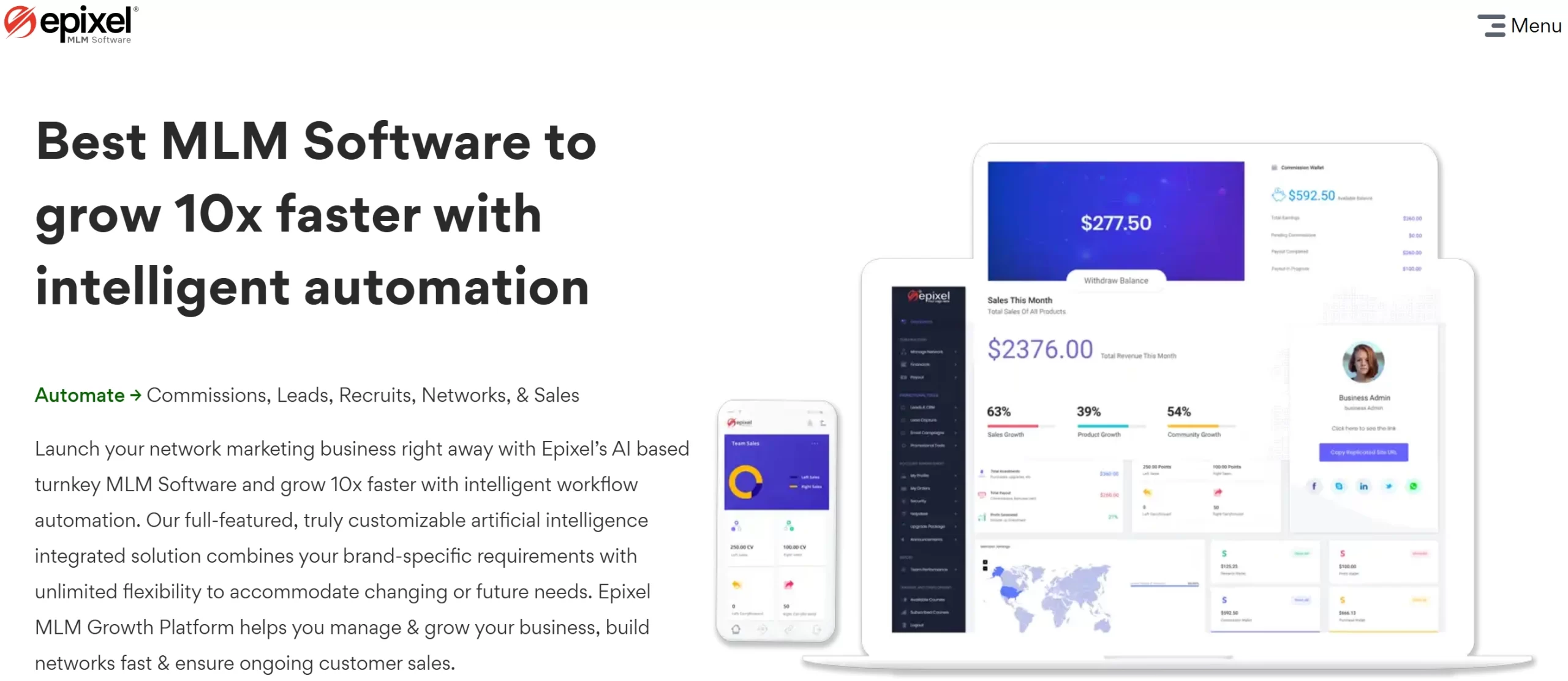
Epixel’s platform comes with AI‑driven automation, including smart onboarding, lead management, compensation planning, and marketing workflows. Their AI capabilities also help predict sales trends, suggest optimal incentive structures, and improve recruiter performance, all via a mobile‑friendly interface.
3. ProMLM Software

ProMLM leverages AI features to simplify complex MLM operations. Its mobile app offers real-time performance monitoring, lead management, and automated commission calculations. The platform supports multiple compensation plans, including binary, unilevel, and matrix, making it suitable for a wide range of network marketing businesses.
4. MarketPowerPRO

MarketPowerPRO is a mobile MLM software with replicated distributor sites, e-commerce integration, and real-time commission tracking. Its mobile interface lets distributors manage orders and sales anywhere. With support for 85+ payment gateways and multiple compensation plans, it suits established businesses needing a robust back office.
5. Flight Commerce
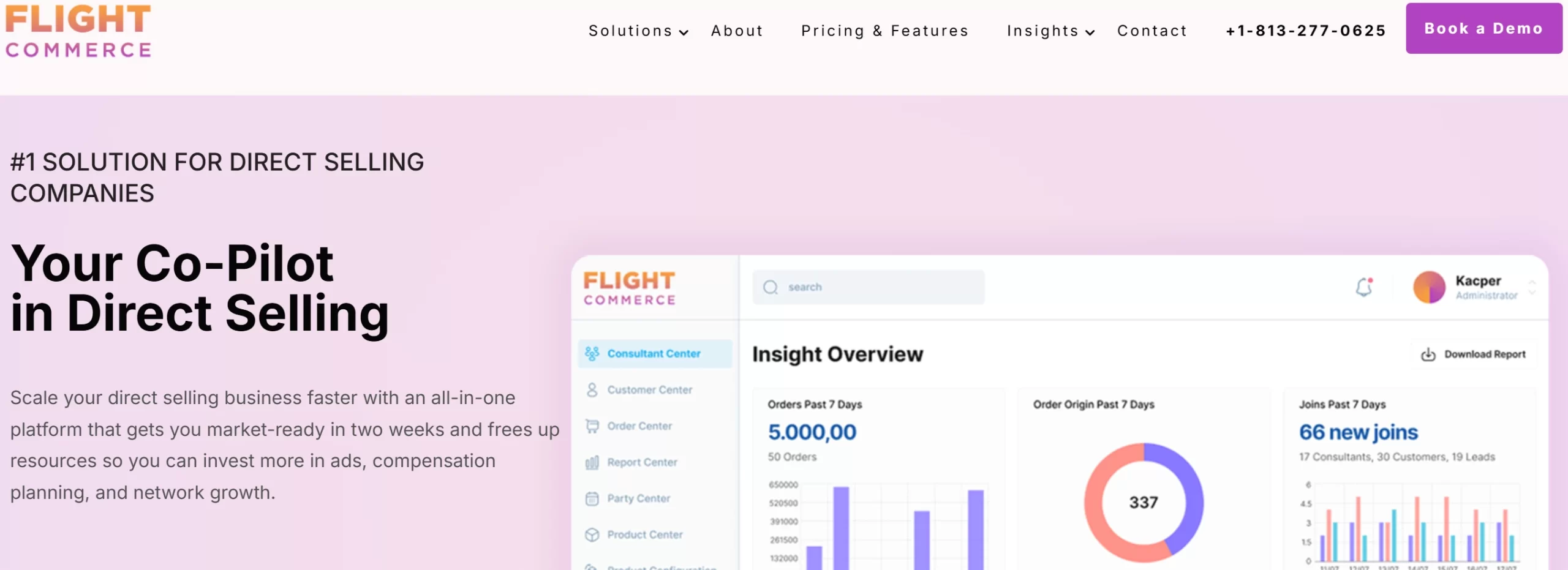
Flight Commerce integrates MLM operations with e-commerce on a mobile platform. Distributors can manage sales, track downlines, and access marketing tools easily. Its API-driven setup allows for simple configuration, and it supports multiple currencies and languages, making it ideal for international networks.
Conclusion
Building an effective platform requires careful planning, secure architecture, and intuitive design. Mobile MLM software development focuses on enabling seamless network management, real-time tracking, and automated commission calculations. By integrating features like user-friendly dashboards, reporting tools, and secure payment gateways, businesses can empower their distributors while ensuring transparency and efficiency. Prioritizing scalability, performance, and compliance ensures the software can support growing networks without disruption. A strategic approach to mobile MLM software development transforms complex network operations into a streamlined, reliable, and user-centric experience for both administrators and participants.
Why Choose IdeaUsher for Mobile MLM Software Development?
At IdeaUsher, we build mobile MLM software that enables efficient network management, real-time commission tracking, and secure payment processing. Our expertise ensures apps are scalable, transparent, and optimized for distributors to manage their teams effectively.
Why Work with Us?
- Tailored MLM Solutions: We design software that aligns with your business model and growth goals.
- Robust Technology: Our apps integrate secure cloud databases, analytics, and mobile frameworks for seamless operations.
- Proven Experience: We have successfully delivered MLM platforms that simplify network management and enhance productivity.
- Security and Compliance: We prioritize data privacy, financial security, and compliance with industry standards.
Explore our portfolio to see how we have helped global brands launch impactful MLM solutions.
Connect with us today to develop your next mobile MLM software that empowers your network and drives growth.
Work with Ex-MAANG developers to build next-gen apps schedule your consultation now
FAQs
Mobile MLM software development involves creating applications that help manage multi-level marketing networks. These apps enable real-time tracking of sales, commissions, network growth, and communication between distributors, streamlining operations and improving efficiency.
Essential features include distributor dashboards, commission tracking, network visualization, secure payment gateways, reporting tools, and push notifications. These functionalities empower users to manage teams effectively while maintaining transparency and accountability.
MLM apps use cloud databases, secure APIs, mobile frameworks like React Native or Flutter, payment integrations, and analytics tools. These technologies ensure real-time updates, scalability, and secure management of financial and network data.
Scalability and security are achieved through robust cloud infrastructure, encrypted data storage, secure authentication, regular updates, and compliance with financial regulations. This ensures the app can support growing networks without risking data breaches or downtime.
